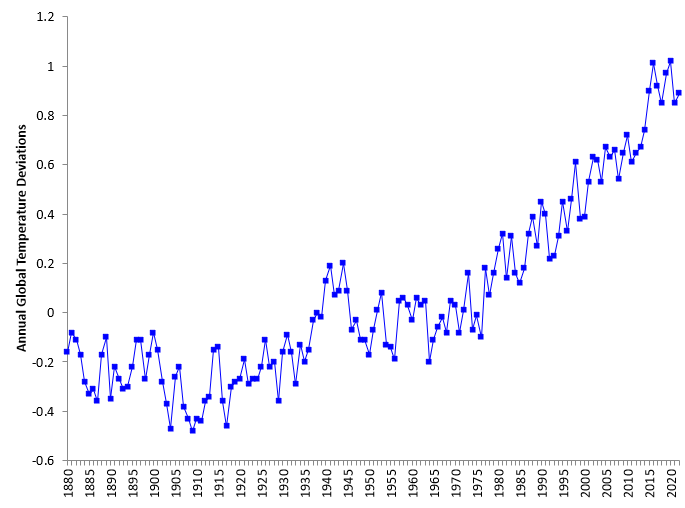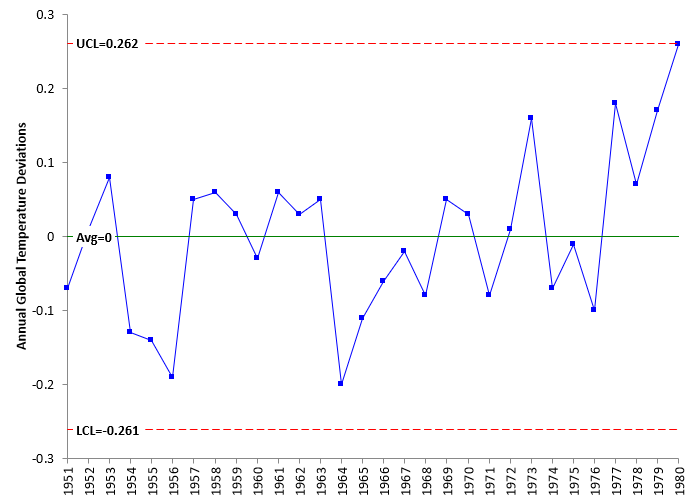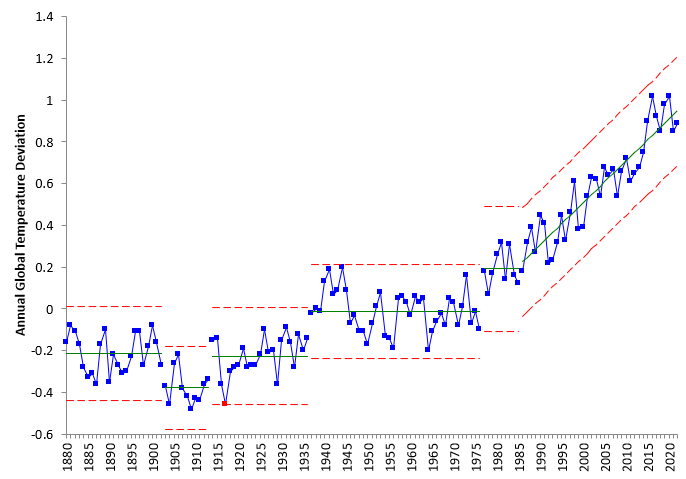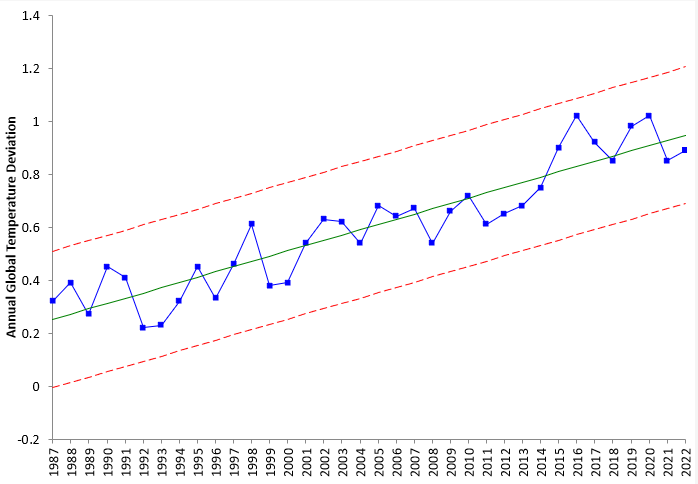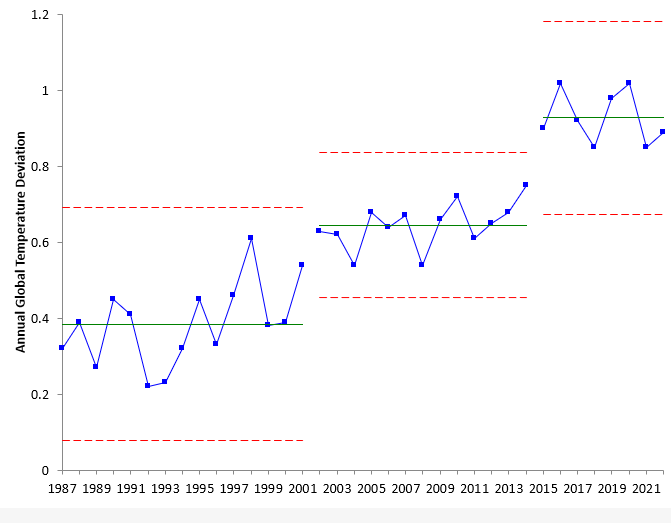January 2023
(Note: all the previous SPC Knowledge Base in the control chart examples category are listed on the right-hand side. Select this link for information on the SPC for Excel software.)

- Was 2022 the hottest year ever recorded?
- How are the global temperature deviations calculated?
- How do control charts help analyze the global temperature deviations data?
- What is the baseline data that are used for the global temperature deviation calculations?
- Have there been stable patterns in the past for the global temperature deviations?
- When did the global temperature deviations start increasing?
- Is the increase in global temperature deviations predictable?
- Are there any possible stable periods recently?
- What past publications do you have on global warming?
Plus we have our:
You may download a pdf version of this publication at this link. Please feel free to leave a comment at the end of the publication.
Was 2022 The Hottest Year Ever Recorded?
No, it is not. It is the 6th warmest year ever recorded. 2020 is the hottest year ever recorded. Figure 1 shows the annual global temperature deviations (°C) from 1880 to 2022 as a run chart – and clearly shows that the temperature has been rising since the 1980’s.
Figure 1: Annual Global Temperature Deviations from 1880 to 2022
It is easy to see that the last nine years have been the warmest since 1880. But the last eight years seem to have formed a pattern on their on. These eight are significantly above the rest of the data. Has something changed?
How Are the Global Temperature Deviations Calculated?
You can access the data used in this publication at this link. This link takes you to the Goddard Institute for Space Studies (GISS) website which is part of the National Aeronautics and Space Administration (NASA). The data are given as a deviation from the baseline period from 1951 – 1980. For example, the average global temperature deviation for 2022 is 0.89 °C. This means that 2022 was, on average, 0.89 °C higher than the baseline mean from 1951 to 1980. The raw data are given as the change in monthly deviations. The 12 months for the year are averaged to give the annual global temperature deviation. Table 1 shows the temperature deviations for each month in 2022.
Table 1: 2022 Monthly Temperature Deviations
| Month | Deviation | Month | Deviation | |
|---|---|---|---|---|
| Jan-22 | 0.91 | Jul-22 | 0.93 | |
| Feb-22 | 0.89 | Aug-22 | 0.95 | |
| Mar-22 | 1.05 | Sep-22 | 0.90 | |
| Apr-22 | 0.84 | Oct-22 | 0.97 | |
| May-22 | 0.84 | Nov-22 | 0.72 | |
| Jun-22 | 0.92 | Dec-22 | 0.80 |
The average of these 12 months is 0.89, which is reported then as the annual global temperature deviation.
How Do Control Charts Help Analyze the Global Temperature Deviations Data?
If a process stays the same over time, it is consistent and predictable – it is in statistical control. Control charts help us determine this. They will signal you when the process has changed. To use a control chart, you plot the data over time and then add the average and the control limits. The control limits define the range of the data you would expect if the process was consistent and predictable. As long as there are no points beyond the control limits or patterns in the data, the process is in statistical process. Control charts can easily be applied to the global temperature deviation data. The individuals control (X-mR) chart is used for the control charts in this publication. These were made using the SPC for Excel software. Only the X chart is used.
What Is the Baseline Data That Are Used for the Global Temperature Deviation Calculations?
The baseline data used by NASA is from 1951 – 1980. Hopefully, this baseline data period is consistent and predictable. A control chart can be used to determine this. Figure 2 is the control chart for the baseline data period.
Figure 2: Baseline Data Control Chart
The annual global temperature deviations from 1951 to 1980 are plotted over time. The average is 0 as you would expect since the deviations are based on the average temperature from 1951 to 1980. The chart in Figure 2 is in statistical control. There are no points beyond the control limits and no patterns present.
Have There Been Stable Patterns in the Past for the Global Temperature Deviations?
Yes, there have been. These were analyzed in our previous publications on global warming (see below for links). In fact, prior to 1987, there have been five periods of stable global temperature deviations. The chart is shown in Figure 3.
Figure 3: Annual Global Temperature Deviations from 1880 to 2022
Prior to 1987, there are five periods of fairly stable global temperatures. Figure 3 splits the control limits at various places with each segment meant to represent a period where the temperature was not changing significantly. There have been 5 periods of “stable” global temperature deviations:
- 1880 – 1902 with an average of -0.21
- 1903 – 1913 with an average of -0.38
- 1914 – 1936 with an average of -0.23
- 1937 – 1976 with an average of -0.01
- 1977 – 1986 with an average of 0.19
Since 1987, the temperature deviation has been increasing. The SPC for Excel software can check for trends and add account for that trend in the control chart, as was done for the data from 1987 on. More on that in the next section.
When Did the Global Temperature Deviations Start Increasing?
1987 is when the global temperature deviations began to start increasing significantly. This is seen as the trend at the right in Figure 3. Figure 4 shows the trend control chart for this time period. A trend control chart is used when there is a predictable change in the data over time.
Figure 4: Annual Global Temperature Deviations Trend from 1987 – 2022
This process is predictable and consistent. It appears to be in statistical control.
Is The Increase in Global Temperature Deviations Predictable?
Since the process is in control, it is predictable. This year’s global temperature deviation will be between the control limits for 2022. The center line is the best fit linear equation and is given by:
Annual Global Temperature Deviation = -39.271+ 0.0199(Year)
You can use this equation to predict a single value for this year:
Annual Global Temperature Deviation = -39.271 + 0.0199(2023) = 0.97
This analysis then predicts that the average global temperature for 2023 will be 0.97 °C above the baseline. Last year’s publication predicted a value of 0.95 for 2022 global temperature deviation. The actual was 0.89.
Are There Any Possible Stable Periods Recently?
It does not appear that the global temperature has been increasing over the last, now, 8 years. It looks like it has leveled off as you can see in Figure 1. Good news for global warming? No, not yet. The problem is that this pattern has shown up before – where the temperature has leveled off for a time period and then increased. You can take the data in Figure 4 and not treat it as a trend chart but instead look for areas where the temperatures are not increasing but are the same – like the periods before 1987 in Figure 3. Figure 5 shows the data in Figure 4 but without the trend.
Figure 5: Annual Global Temperature Deviations from 1987 – 2022
Figure 5 shows that the trend could be interpreted as three step changes. The last eight years represent a step change in the global temperature deviations and represents a period when those temperatures are not getting hotter or colder. They are staying essentially the same from year to year.
You can breakdown two other periods since 1987 that appear consistent. The previous period was from 2002 – 2014, which represents 13 years. The 15 years from 1987 represent another period.
Based on the chart, there is no reason to believe this kind of pattern won’t repeat itself – there will be a few more years in the range to the right of Figure 5 and then another likely step change upward. This will continue unless the chart shows a shift downward in the data – over a period of several years.
What Past Publications Do You Have on Global Warming?
We have seven previous publications on using control charts to analyze global temperature. These are briefly described below.
- SPC and Global Warming (December 2015): This publication used global temperature data referred to as dTs data. These are data based on the meteorological station data. This publication showed the periods where the global temperature was essentially stable. There were five such periods, each followed by a sudden increase in the global temperature. It also showed the trend that began in 1997. This trend was used to predict the global temperature for 2016.
- Trend Control Charts and Global Warming (January 2016): This publication expanded on how to use trend control charts and the calculations involved. Global warming data was used as the example.
- SPC and Global Warming Update (February 2017): This publication updated the results with the 2016 data. The data used in this analysis was the LOTI (land-ocean temperature index) data. The LOTI data are considered more accurate than the dTs data used in the first publication listed above. This is also where it was discovered that the historical data had changed somewhat since it was examined in 2015.
- SPC and Global Warming – 2017 Update (March 2018): This publication updated the results through 2017 data.
- Global Warming: A Trend or Step Changes? (June 2020): This publication focused on if it was better to use a trend control chart for the period since 1997 or to use a series of step changes in the process.
- SPC and Global Warming: 1880 – 2020 (January 2021): This publication was similar to our first one. The control charts were updated to reflect using the LOTI data instead of the dTs data. There are differences between the two datasets, and it does not appear that GISS uses the dTs data anymore. It might surprise you that, over the time span from 1880 to 2020, there have only been stable periods. The first five stable periods had consistent, predictable temperatures. The last period has also been consistent – except the global temperature is trending up in a fairly predictable pattern.
- SPC and Global Warming: 1880-2021 (January 2022): This publication continued our look at global warming by including the 2021 data. The model from our previous publication had predicted an annual global temperature deviation in 2021 of 0.948. The actual number was 0.85. The previous publication used a trend control chart for the data from 1987 through 2020. The new data for 2021 shows that the global deviations over the past 7 years are stable – the global temperature is not getting hotter or cooler. It also showed that this pattern has existed before.
Summary
This publication continued our look at global warming by including the 2022 data. The new data for 2022 shows that the global deviations over the past 8 years are stable – the global temperature is not getting hotter or cooler. It also showed that this pattern has existed before. There is a period where the temperature is stable – not significantly changing – and then there is a step change upward. The chart shows no reason to believe that this pattern will not continue over time – at least for now. The two patterns before the last 8 years lasted 15 and 13 years – so it may be awhile before we seen the next upswing in warming.
